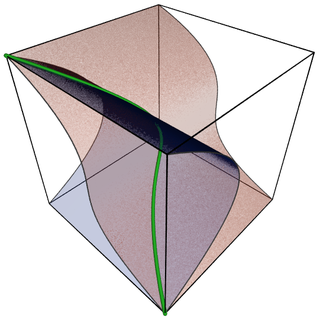Related Research Articles
In mathematics, a unique factorization domain (UFD) is a ring in which a statement analogous to the fundamental theorem of arithmetic holds. Specifically, a UFD is an integral domain in which every non-zero non-unit element can be written as a product of irreducible elements, uniquely up to order and units.

In mathematics, a commutative ring is a ring in which the multiplication operation is commutative. The study of commutative rings is called commutative algebra. Complementarily, noncommutative algebra is the study of ring properties that are not specific to commutative rings. This distinction results from the high number of fundamental properties of commutative rings that do not extend to noncommutative rings.

Commutative algebra, first known as ideal theory, is the branch of algebra that studies commutative rings, their ideals, and modules over such rings. Both algebraic geometry and algebraic number theory build on commutative algebra. Prominent examples of commutative rings include polynomial rings; rings of algebraic integers, including the ordinary integers ; and p-adic integers.

Algebraic varieties are the central objects of study in algebraic geometry, a sub-field of mathematics. Classically, an algebraic variety is defined as the set of solutions of a system of polynomial equations over the real or complex numbers. Modern definitions generalize this concept in several different ways, while attempting to preserve the geometric intuition behind the original definition.
In mathematics, the Weierstrass preparation theorem is a tool for dealing with analytic functions of several complex variables, at a given point P. It states that such a function is, up to multiplication by a function not zero at P, a polynomial in one fixed variable z, which is monic, and whose coefficients of lower degree terms are analytic functions in the remaining variables and zero at P.
In mathematics, complex multiplication (CM) is the theory of elliptic curves E that have an endomorphism ring larger than the integers. Put another way, it contains the theory of elliptic functions with extra symmetries, such as are visible when the period lattice is the Gaussian integer lattice or Eisenstein integer lattice.
In mathematics, and particularly in potential theory, Dirichlet's principle is the assumption that the minimizer of a certain energy functional is a solution to Poisson's equation.
In mathematics, Hilbert's fourteenth problem, that is, number 14 of Hilbert's problems proposed in 1900, asks whether certain algebras are finitely generated.
Masayoshi Nagata was a Japanese mathematician, known for his work in the field of commutative algebra.
In mathematics, a Weierstrass point on a nonsingular algebraic curve defined over the complex numbers is a point such that there are more functions on , with their poles restricted to only, than would be predicted by the Riemann–Roch theorem.
In mathematics, a commutative ring R is catenary if for any pair of prime ideals p, q, any two strictly increasing chains
In commutative algebra, an N-1 ring is an integral domain whose integral closure in its quotient field is a finitely generated -module. It is called a Japanese ring if for every finite extension of its quotient field , the integral closure of in is a finitely generated -module. A ring is called universally Japanese if every finitely generated integral domain over it is Japanese, and is called a Nagata ring, named for Masayoshi Nagata, or a pseudo-geometric ring if it is Noetherian and universally Japanese. A ring is called geometric if it is the local ring of an algebraic variety or a completion of such a local ring, but this concept is not used much.
In mathematics, a Henselian ring is a local ring in which Hensel's lemma holds. They were introduced by Azumaya (1951), who named them after Kurt Hensel. Azumaya originally allowed Henselian rings to be non-commutative, but most authors now restrict them to be commutative.

In mathematics, more specifically algebra, abstract algebra or modern algebra is the study of algebraic structures. Algebraic structures include groups, rings, fields, modules, vector spaces, lattices, and algebras over a field. The term abstract algebra was coined in the early 20th century to distinguish it from older parts of algebra, and more specifically from elementary algebra, the use of variables to represent numbers in computation and reasoning. The abstract perspective on algebra has become so fundamental to advanced mathematics that it is simply called "algebra", while the term "abstract algebra" is seldom used except in pedagogy.

In mathematics, a noncommutative ring is a ring whose multiplication is not commutative; that is, there exist a and b in the ring such that ab and ba are different. Equivalently, a noncommutative ring is a ring that is not a commutative ring.
In algebraic geometry, a Zariski–Riemann space or Zariski space of a subring k of a field K is a locally ringed space whose points are valuation rings containing k and contained in K. They generalize the Riemann surface of a complex curve.
In algebra, an analytically irreducible ring is a local ring whose completion has no zero divisors. Geometrically this corresponds to a variety with only one analytic branch at a point.
In algebra, an analytically normal ring is a local ring whose completion is a normal ring, in other words a domain that is integrally closed in its quotient field.
In mathematics, a Hironaka decomposition is a representation of an algebra over a field as a finitely generated free module over a polynomial subalgebra or a regular local ring. Such decompositions are named after Heisuke Hironaka, who used this in his unpublished master's thesis at Kyoto University.
In algebra, the theorem of transition is said to hold between commutative rings if
- dominates ; i.e., for each proper ideal I of A, is proper and for each maximal ideal of B, is maximal
- for each maximal ideal and -primary ideal of , is finite and moreover
References
- ↑ Nagata (1975 , section 45)
